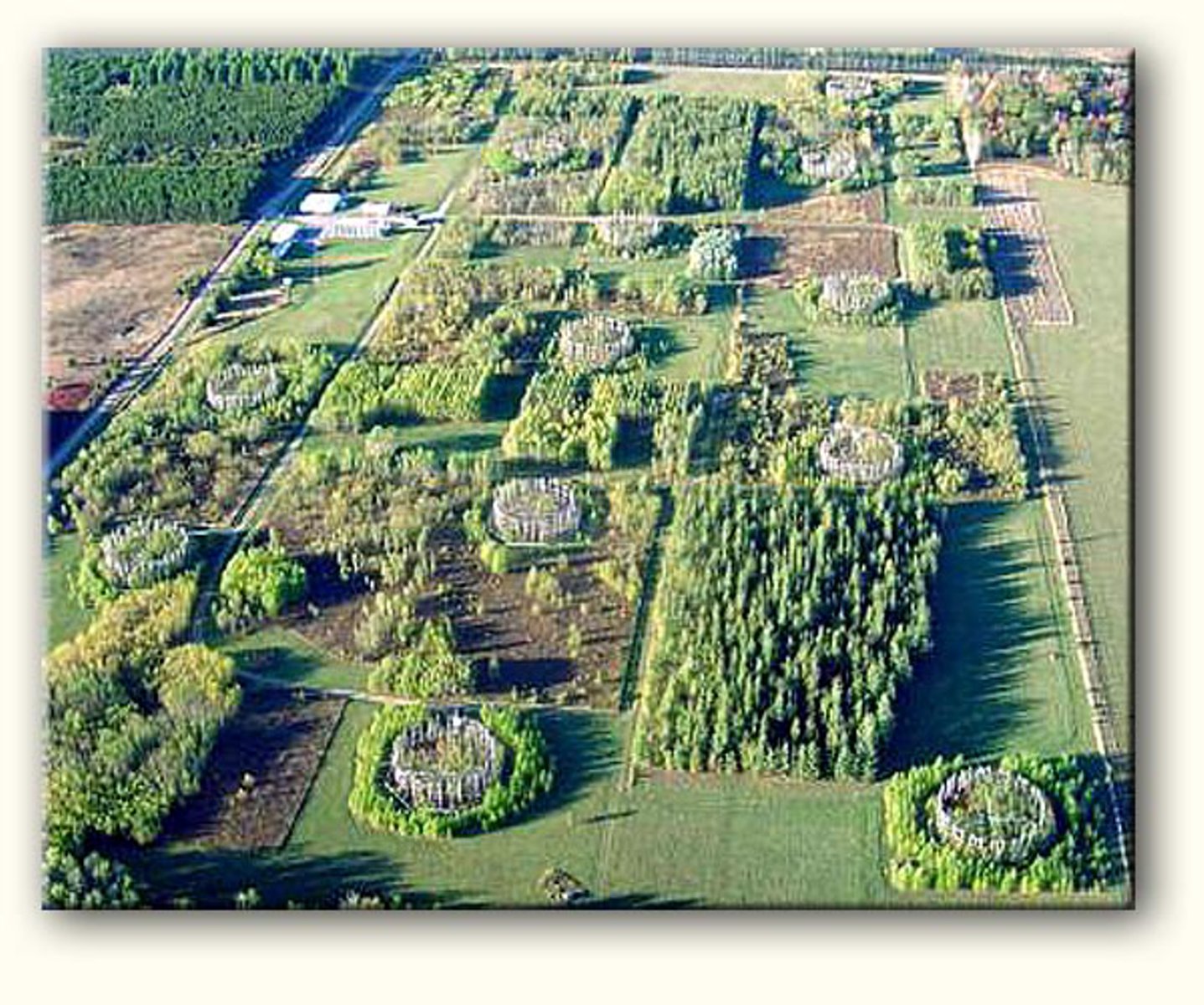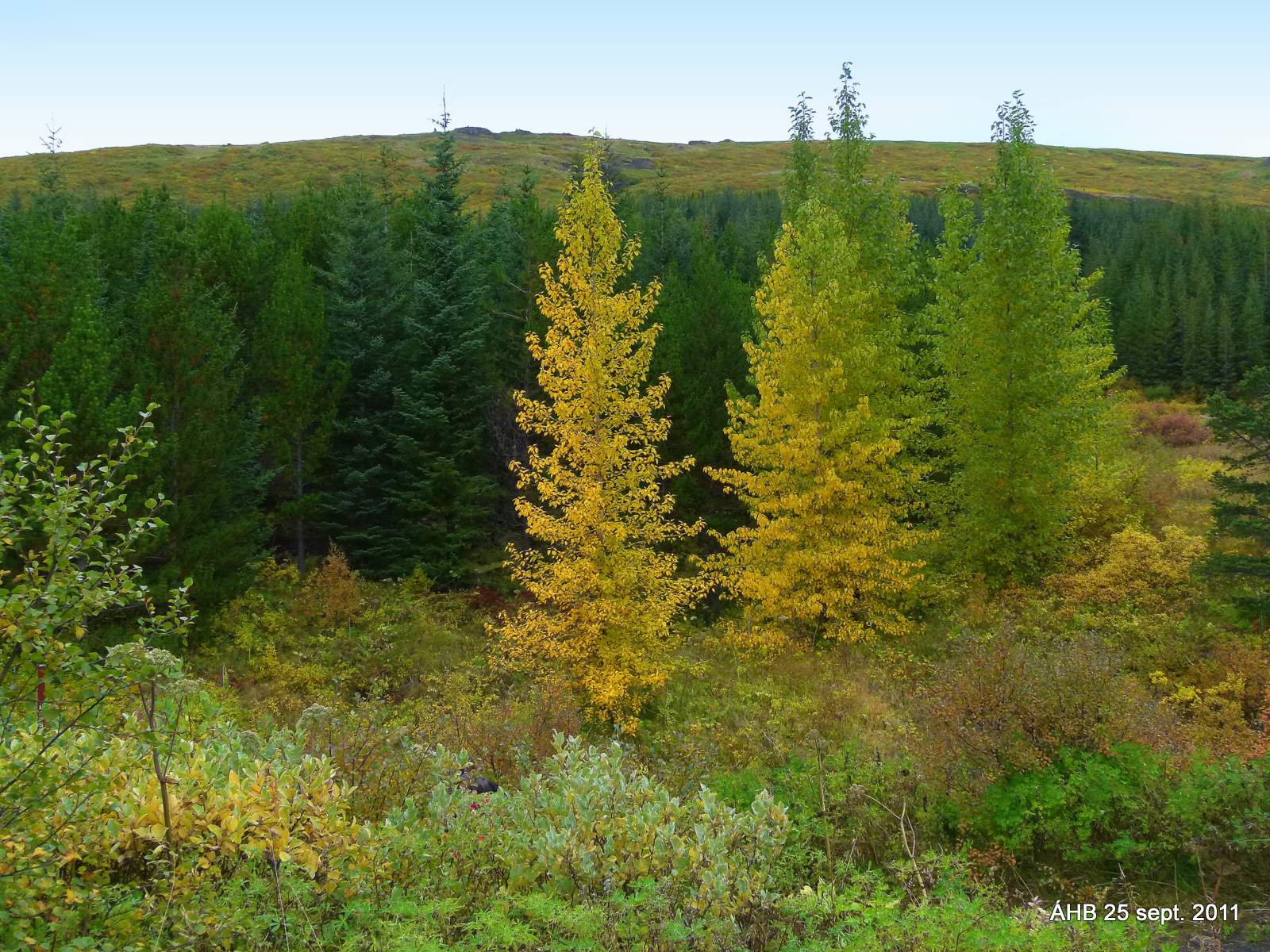Mánudagur, 31. október 2011
Skógar gætu bundið meira CO2 en áður var talið...
Fróðleg grein um skóga birtist fyrir skömmu á Science Daily vefnum. Samkvæmt greininni virðist sem skógurinn hafi meiri hæfileika til að binda koltvísýring en áður var talið. Greinin er hér. Í tilrauninni, sem stóð yfir í 12 ár á um 20 hektara landi, var styrkur koltvísýrings umhverfis trjákrónurnar aukinn, auk þess sem notað var ózon til að líkja eftir menguðu lofti. Auk þess sem talið er að aukið magn koltvísýrings hafi áhrif til hækkunar hitastigs, virkar það sem áburður á vöxt gróðurs, eins og fram kemur í greininni sem birt er hér fyrir neðan. Fyrri rannsóknir höfðu gefið til kynna að þessi áhrif á vöxt trjánna væru tímabundin, þar sem að því kæmi að plönturnar næðu ekki nægu magni að köfnunarefni eða nitur úr jarðveginum. Í ljós kom í þessari tilraun að vöxtur trjánna hélst hraður allan tíman sem rannsóknin fór fram, og síðustu 3 árin var vaxtarhraðinn 26% meiri en samanburðartrjánna sem fengu ekki aukið magn koltvísýrings. Svo virðist sem hæfileiki trjánna til að vinna köfnunarefi úr jarðveginum hafi aukist, og einnig að örverur hafi skilað aftur köfnunarefni hraðar í jarðveginn með auknu magni laufa sem féllu af trjánum að hausti. Heildaráhrif ózons á skóginn voru lítil, þó svo gróðurinn þyldi það misvel. Ýmislegt fleira fróðlegt kom fram í tilrauninni og er vel þess virði að lesa allan greinarstúfinn sem hér fylgir. Þetta eru ánægjulegar fréttir fyrir skógræktarfólk og einnig þá sem áhyggjur hafa að hækkuðu hitastigi jarðar.
Myndin hér að ofan sýnir tilraunareitinn sem er 38 ekrur að stærð. Tilraunin stóð yfir á árunum 1997-2008
|
Meginflokkur: Vísindi og fræði | Aukaflokkur: Umhverfismál | Breytt 1.11.2011 kl. 07:49 | Facebook
Um bloggið
Ginnungagap
Ýmislegt
Loftslag
Teljari
Álverð
Sólin í dag:
(Smella á mynd)
.
Olíuverðið í dag:
Nýjustu færslur
- Kínverskur loftbelgur yfir Ameríku, og Amerískur belgur yfir ...
- Vísindavefurinn: Getum við seinkað klukkunni á Íslandi og fen...
- Sjálfstæðisflokkurinn með tæplega 19% meira fylgi en Samfylki...
- Bjarni Sigurðsson harmonikkusnillingur frá Geysi. Fáein orð...
- Hvers vegna valdi Apple ekki Ísland fyrir gagnaver...?
Heimsóknir
Flettingar
- Í dag (31.7.): 1
- Sl. sólarhring: 19
- Sl. viku: 108
- Frá upphafi: 768194
Annað
- Innlit í dag: 1
- Innlit sl. viku: 80
- Gestir í dag: 1
- IP-tölur í dag: 1
Uppfært á 3 mín. fresti.
Skýringar
Tenglar
Tenglar
Ýmsar vefsíður
- Efnisyfirlit pistla
- Lofthiti - Sjávarstaða - Hafís - Sólvirkni... Beintengdir ferlar
- Club du Soleil Greinar um samaspil sólar og veðurfars
- Stjörnufræðivefurinn
- Astronomy Picture of the Day
- Climate4you
- Watts Up With That?
- World Climate Report
- CO2 Science
- The Reference Frame
- Climate-Audit
- ICECAP
- The Air Went
- Science Sceptical Blog
- Roy Spencer
- Friends of Sience
- Prometheus
- Öldur aldanna. Sjaldan er ein báran stök - einnig í veðurfari? (2003) Vefsíða ÁHB
- Gróðurhúsaáhrif eða eðlilegar sveiflur í virkni sólar? (Grein í Lesbók Mbl. 20. júní 1998) Höfundur Ágúst H. Bjarnason
- Er jörðin að hitna?-Ekki er allt sem sýnist (1998) Vefsíða ÁHB
Uppskriftir
Ýmsar mataruppskriftir
Myndaalbúm
Bloggvinir
-
 majab
majab
-
 ragu
ragu
-
 amadeus
amadeus
-
 andres08
andres08
-
 apalsson
apalsson
-
 asabjorg
asabjorg
-
 askja
askja
-
 astromix
astromix
-
 baldher
baldher
-
 biggibraga
biggibraga
-
 bjarkib
bjarkib
-
 bjarnijonsson
bjarnijonsson
-
 bjarnimax
bjarnimax
-
 bjorn-geir
bjorn-geir
-
 blindur
blindur
-
 bofs
bofs
-
 brandarar
brandarar
-
 daliaa
daliaa
-
 darwin
darwin
-
 duddi9
duddi9
-
 ea
ea
-
 egillsv
egillsv
-
 einari
einari
-
 einarstrand
einarstrand
-
 elinora
elinora
-
 elvira
elvira
-
 emilhannes
emilhannes
-
 esv
esv
-
 eyjapeyji
eyjapeyji
-
 fhg
fhg
-
 finder
finder
-
 finnur
finnur
-
 fjarki
fjarki
-
 flinston
flinston
-
 frisk
frisk
-
 gattin
gattin
-
 geiragustsson
geiragustsson
-
 gillimann
gillimann
-
 gretaro
gretaro
-
 gthg
gthg
-
 gudmbjo
gudmbjo
-
 gudni-is
gudni-is
-
 gummibraga
gummibraga
-
 gun
gun
-
 gutti
gutti
-
 haddi9001
haddi9001
-
 halldorjonsson
halldorjonsson
-
 halldors
halldors
-
 hlini
hlini
-
 hof
hof
-
 hordurhalldorsson
hordurhalldorsson
-
 hreinsamviska
hreinsamviska
-
 hronnsig
hronnsig
-
 hugdettan
hugdettan
-
 icekeiko
icekeiko
-
 ingibjorgelsa
ingibjorgelsa
-
 jakobbjornsson
jakobbjornsson
-
 jakobk
jakobk
-
 johannesthor
johannesthor
-
 johnnyboy99
johnnyboy99
-
 jonaa
jonaa
-
 jonasgunnar
jonasgunnar
-
 jonmagnusson
jonmagnusson
-
 jonpallv
jonpallv
-
 jonthorolafsson
jonthorolafsson
-
 juliusvalsson
juliusvalsson
-
 karljg
karljg
-
 katrinsnaeholm
katrinsnaeholm
-
 kikka
kikka
-
 kje
kje
-
 klarak
klarak
-
 kolbrunb
kolbrunb
-
 krissiblo
krissiblo
-
 ksh
ksh
-
 kt
kt
-
 lehamzdr
lehamzdr
-
 liljabolla
liljabolla
-
 lillagud
lillagud
-
 lindalea
lindalea
-
 lucas
lucas
-
 maeglika
maeglika
-
 maggij
maggij
-
 maggiraggi
maggiraggi
-
 marinomm
marinomm
-
 martasmarta
martasmarta
-
 marzibil
marzibil
-
 mberg
mberg
-
 midborg
midborg
-
 minos
minos
-
 morgunbladid
morgunbladid
-
 mosi
mosi
-
 mullis
mullis
-
 naflaskodun
naflaskodun
-
 nimbus
nimbus
-
 nosejob
nosejob
-
 omarbjarki
omarbjarki
-
 ormurormur
ormurormur
-
 palmig
palmig
-
 perlaoghvolparnir
perlaoghvolparnir
-
 peturmikli
peturmikli
-
 photo
photo
-
 possi
possi
-
 prakkarinn
prakkarinn
-
 raggibjarna
raggibjarna
-
 rattati
rattati
-
 ravenyonaz
ravenyonaz
-
 redlion
redlion
-
 rs1600
rs1600
-
 rynir
rynir
-
 saemi7
saemi7
-
 sesseljamaria
sesseljamaria
-
 sigfus
sigfus
-
 sigurgeirorri
sigurgeirorri
-
 sjalfstaedi
sjalfstaedi
-
 sjerasigvaldi
sjerasigvaldi
-
 skari60
skari60
-
 skulablogg
skulablogg
-
 sleggjudomarinn
sleggjudomarinn
-
 stebbix
stebbix
-
 steinibriem
steinibriem
-
 steinnhaf
steinnhaf
-
 stinajohanns
stinajohanns
-
 stjornuskodun
stjornuskodun
-
 storibjor
storibjor
-
 straitjacket
straitjacket
-
 summi
summi
-
 tannibowie
tannibowie
-
 thil
thil
-
 thjodarskutan
thjodarskutan
-
 throsturg
throsturg
-
 toro
toro
-
 tryggvigunnarhansen
tryggvigunnarhansen
-
 valdimarjohannesson
valdimarjohannesson
-
 valdinn
valdinn
-
 vefritid
vefritid
-
 vey
vey
-
 vidhorf
vidhorf
-
 vig
vig
-
 visindin
visindin
-
 vulkan
vulkan
-
 kristjan9
kristjan9
-
 arkimedes
arkimedes
-
 kliddi
kliddi
-
 eliasbe
eliasbe
Eldri færslur
- Febrúar 2023
- Janúar 2019
- Maí 2018
- Júlí 2017
- Maí 2017
- Febrúar 2017
- Janúar 2017
- Nóvember 2016
- Október 2016
- September 2016
- Júlí 2016
- Apríl 2016
- Mars 2016
- Febrúar 2016
- Janúar 2016
- Desember 2015
- Nóvember 2015
- Október 2015
- Ágúst 2015
- Júní 2015
- Maí 2015
- Apríl 2015
- Mars 2015
- Febrúar 2015
- Janúar 2015
- Desember 2014
- Nóvember 2014
- Október 2014
- September 2014
- Ágúst 2014
- Júlí 2014
- Júní 2014
- Maí 2014
- Apríl 2014
- Mars 2014
- Febrúar 2014
- Janúar 2014
- Desember 2013
- Nóvember 2013
- Október 2013
- September 2013
- Ágúst 2013
- Júlí 2013
- Júní 2013
- Maí 2013
- Apríl 2013
- Mars 2013
- Febrúar 2013
- Janúar 2013
- Desember 2012
- Nóvember 2012
- September 2012
- Ágúst 2012
- Júlí 2012
- Júní 2012
- Maí 2012
- Apríl 2012
- Mars 2012
- Febrúar 2012
- Janúar 2012
- Desember 2011
- Nóvember 2011
- Október 2011
- September 2011
- Ágúst 2011
- Júlí 2011
- Júní 2011
- Apríl 2011
- Mars 2011
- Febrúar 2011
- Janúar 2011
- Desember 2010
- Nóvember 2010
- Október 2010
- September 2010
- Ágúst 2010
- Júlí 2010
- Júní 2010
- Maí 2010
- Apríl 2010
- Mars 2010
- Febrúar 2010
- Janúar 2010
- Desember 2009
- Nóvember 2009
- Október 2009
- September 2009
- Ágúst 2009
- Júlí 2009
- Júní 2009
- Maí 2009
- Apríl 2009
- Mars 2009
- Febrúar 2009
- Janúar 2009
- Desember 2008
- Nóvember 2008
- Október 2008
- September 2008
- Ágúst 2008
- Júlí 2008
- Júní 2008
- Maí 2008
- Apríl 2008
- Mars 2008
- Febrúar 2008
- Janúar 2008
- Desember 2007
- Nóvember 2007
- Október 2007
- September 2007
- Ágúst 2007
- Júlí 2007
- Júní 2007
- Apríl 2007
- Mars 2007
- Febrúar 2007
- Janúar 2007
- Desember 2006
- Nóvember 2006
- Október 2006
- September 2006
Færsluflokkar
- Bloggar
- Bækur
- Dægurmál
- Evrópumál
- Ferðalög
- Fjármál
- Fjölmiðlar
- Heilbrigðismál
- Heimspeki
- Íþróttir
- Kjaramál
- Kvikmyndir
- Lífstíll
- Ljóð
- Löggæsla
- Mannréttindi
- Matur og drykkur
- Menning og listir
- Menntun og skóli
- Samgöngur
- Sjónvarp
- Spaugilegt
- Spil og leikir
- Stjórnmál og samfélag
- Sveitarstjórnarkosningar
- Tónlist
- Trúmál
- Trúmál og siðferði
- Tölvur og tækni
- Umhverfismál
- Utanríkismál/alþjóðamál
- Vefurinn
- Viðskipti og fjármál
- Vinir og fjölskylda
- Vísindi og fræði








